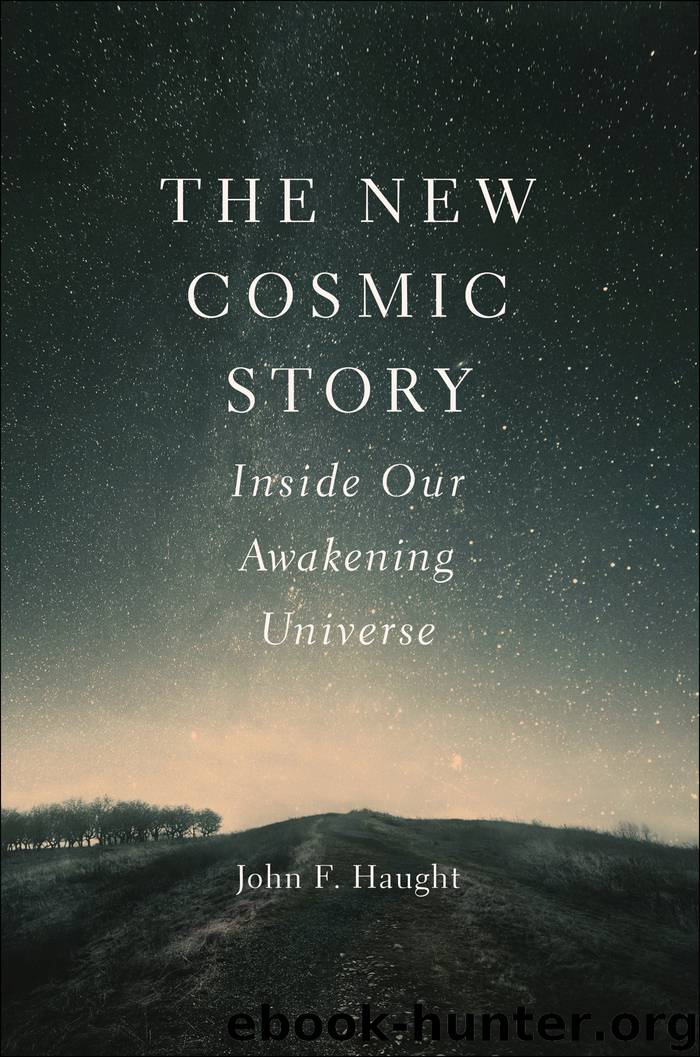New Cosmic Story by John F. Haught

Author:John F. Haught
Language: eng
Format: epub
Publisher: Yale University Press
Published: 2017-12-27T05:00:00+00:00
Religious Symbolism in an Unfinished Universe
Religion, then, makes reference to transcendent rightness chiefly through a combination of silence and symbolism. It refuses adamantly to embrace the modern ideal of absolute clarity and intellectual control over its subject matter. Religious symbols can never be translated fully into the direct kind of reference that modern scientism and rationalism demand. If the content of religious symbols could be fully conveyed in ordinary language or scientific discourse, there would be no awareness of participating in a transcendent rightness at all. Indeed, there would be no religion.
What, though, does religious symbolism look like in the setting of a universe that is still coming into being? To answer this question, once again we need to look even more closely and comparatively at our three ways of reading the universe and religion. Let us begin by providing only a sketch of how each would interpret religious symbols, and then follow this up with a more detailed treatment.
Briefly, the archaeonomic reading interprets religious symbols as purely imaginative fabrications by which humans try to escape from or adapt to a pervasively pointless universe. To archaeonomy the inherently meaningless cosmic process is all that really exists, so any attempt to discover symbolic meaning in it is a cover-up rather than an uncovering. The way of analogy, ignoring the fact that the cosmos is still unfolding in new and unpredictable ways, understands religious symbols as “sacramental” reminders of a perfect, changeless, and sacred world beyond time and space. Anticipation, however, interprets religious symbols as ambiguous advance announcements of a rightness that is still dawning. Religious symbols are the revelation beforehand of what has not yet fully come to pass.
Religious symbols, in this third perspective, are neither illusory projections nor imperfect analogical reminders of an eternal perfection outside of time. Rather, they are installments of a rightness that is both real and waiting to be realized. The cognitive slipperiness of symbols is not a good reason for suspecting them (archaeonomically) of being mere illusions. Nor is it an excuse for interpreting them (analogically) as the hide-and-seek playfulness of a perfection already realized. Rather, from an anticipatory perspective, the ambiguity of religious symbols is a function of their being part of an awakening universe. Religion is symbolic, in other words, because the universe is still coming into being. A realistic appreciation of religious symbols therefore requires that they be approached with the same patience that allows the universe time to become coherent. Let us now examine more closely each of the three ways of reading religious symbolism.
Archaeonomy. The religious use of symbolic expression is the source today of considerable ridicule by scientific naturalists. To contemporary critics of religion such as the New Atheists, faith is nothing more than “belief without evidence.” For them the universal religious claim that what is most real can be approached “only” metaphorically, or by way of symbols, is indicative of what is most wrong with religion. To the pure naturalist, religion’s symbolic mode of reference is a mask for human ignorance and an excuse for self-deception.
Download
This site does not store any files on its server. We only index and link to content provided by other sites. Please contact the content providers to delete copyright contents if any and email us, we'll remove relevant links or contents immediately.
The Lost Art of Listening by Michael P. Nichols(7160)
Why I Am Not A Calvinist by Dr. Peter S. Ruckman(4045)
The Rosicrucians by Christopher McIntosh(3371)
Wicca: a guide for the solitary practitioner by Scott Cunningham(3040)
Signature in the Cell: DNA and the Evidence for Intelligent Design by Stephen C. Meyer(2875)
Real Sex by Lauren F. Winner(2861)
The Holy Spirit by Billy Graham(2775)
To Light a Sacred Flame by Silver RavenWolf(2674)
The End of Faith by Sam Harris(2631)
The Gnostic Gospels by Pagels Elaine(2393)
Waking Up by Sam Harris(2329)
Nine Parts of Desire by Geraldine Brooks(2279)
Jesus by Paul Johnson(2224)
Devil, The by Almond Philip C(2204)
The God delusion by Richard Dawkins(2185)
Heavens on Earth by Michael Shermer(2185)
Kundalini by Gopi Krishna(2089)
Chosen by God by R. C. Sproul(2053)
The Nature of Consciousness by Rupert Spira(1980)
